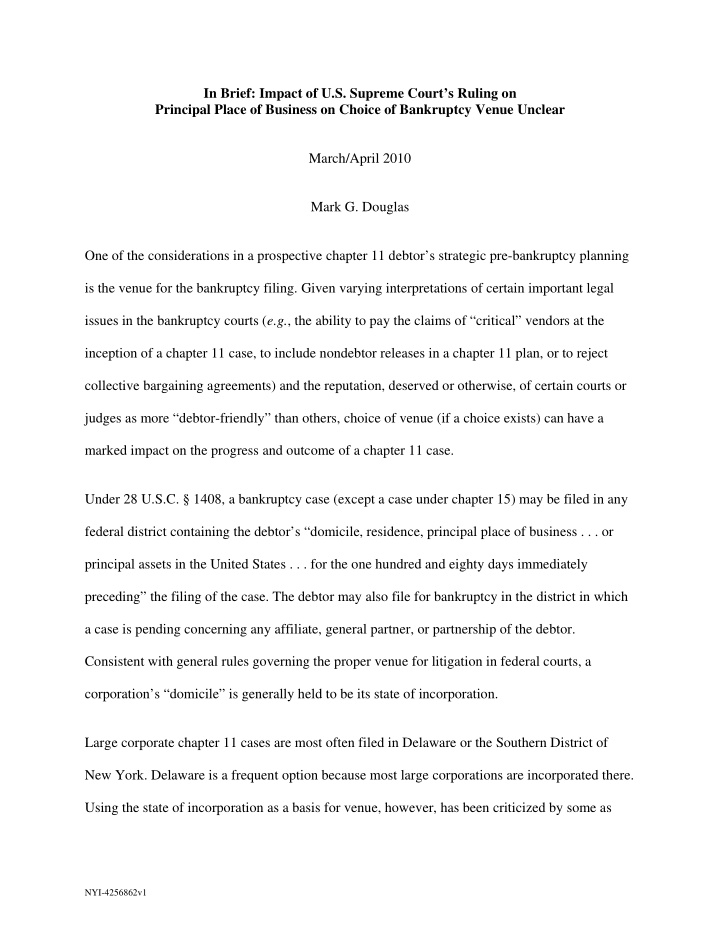



In Brief: Impact of U.S. Supreme Court’s Ruling on Principal Place of Business on Choice of Bankruptcy Venue Unclear March/April 2010 Mark G. Douglas One of the considerations in a prospective chapter 11 debtor’s strategic pre-bankruptcy planning is the venue for the bankruptcy filing. Given varying interpretations of certain important legal issues in the bankruptcy courts ( e.g. , the ability to pay the claims of “critical” vendors at the inception of a chapter 11 case, to include nondebtor releases in a chapter 11 plan, or to reject collective bargaining agreements) and the reputation, deserved or otherwise, of certain courts or judges as more “debtor-friendly” than others, choice of venue (if a choice exists) can have a marked impact on the progress and outcome of a chapter 11 case. Under 28 U.S.C. § 1408, a bankruptcy case (except a case under chapter 15) may be filed in any federal district containing the debtor’s “domicile, residence, principal place of business . . . or principal assets in the United States . . . for the one hundred and eighty days immediately preceding” the filing of the case. The debtor may also file for bankruptcy in the district in which a case is pending concerning any affiliate, general partner, or partnership of the debtor. Consistent with general rules governing the proper venue for litigation in federal courts, a corporation’s “domicile” is generally held to be its state of incorporation. Large corporate chapter 11 cases are most often filed in Delaware or the Southern District of New York. Delaware is a frequent option because most large corporations are incorporated there. Using the state of incorporation as a basis for venue, however, has been criticized by some as NYI-4256862v1
providing a pretext for “forum shopping,” permitting a chapter 11 debtor to sort out its financial problems far removed from creditors and other parties with a stake in the outcome of the case. Legislation has been introduced from time to time to eliminate state of incorporation as a stand- alone basis for venue. Such restrictions, however, have never been enacted. A large corporation that was incorporated in another state and has its principal place of business in yet another state may choose Delaware or New York because it has an office or facility there. However, a ruling recently handed down by the U.S. Supreme Court may bear on the availability of this option, depending upon how U.S. bankruptcy and appellate courts interpret the decision, which did not specifically address bankruptcy venue requirements. On February 23, 2010, the Supreme Court issued its opinion in Hertz v. Friend , 130 S. Ct. 1181 (2010). One of the issues in the case was the location of the principal place of business of a corporation for purposes of diversity jurisdiction. Writing for a unanimous court, Justice Stephen G. Breyer, after examining the federal circuit courts of appeals’ “divergent and increasingly complex interpretations” regarding the issue, ruled as follows: We conclude that “principal place of business” is best read as referring to the place where a corporation’s officers direct, control, and coordinate the corporation’s activities. It is the place that Courts of Appeals have called the corporation’s “nerve center.” And in practice it should normally be the place where the corporation maintains its headquarters—provided that the headquarters is the actual center of direction, control, and coordination, i.e. , the “nerve center,” and not simply an office where the corporation holds its board meetings (for example, attended by directors and officers who have traveled there for the occasion). * * * * A corporation’s “nerve center,” usually its main headquarters, is a single place. The public often (though not always) considers it the corporation’s main place of business. And it is a place within a State. By contrast, the application of a more NYI-4256862v1
general business activities test has led some courts, as in the present case, to look, not at a particular place within a State, but incorrectly at the State itself, measuring the total amount of business activities that the corporation conducts there and determining whether they are “significantly larger” than in the next ranking State. * * * * A “nerve center” approach, which ordinarily equates that “center” with a corporation’s headquarters, is simple to apply comparatively speaking. The metaphor of a corporate “brain,” while not precise, suggests a single location. By contrast, a corporation’s general business activities more often lack a single principal place where they take place. That is to say, the corporation may have several plants, many sales locations, and employees located in many different places. If so, it will not be as easy to determine which of these different business locales is the “principal” or most important “place.” As noted, Hertz did not involve the bankruptcy venue requirements set forth in 28 U.S.C. § 1408. As such, the impact of the ruling on the chosen venue for large corporate bankruptcy cases remains to be seen. NYI-4256862v1
Recommend
More recommend